Blog
Plantar Warts Can Be Treated!
Choosing Shoes For The Work Day
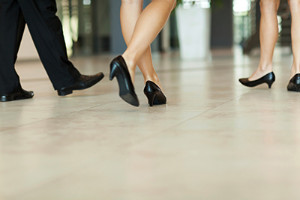 Many people experience uncomfortable foot conditions as a result from standing for long periods of time to complete their work day. Research has shown the importance of wearing proper shoes while working, and this may be beneficial in providing moderate relief. The feet, and overall body, will feel more comfortable when there is adequate room in the shoes for the toes to move freely in. It is helpful to choose shoes that have enough cushioning, and shoes that have a wide heel to provide ankle stability. If the feet become swollen during the work day, it is recommended to elevate them during designated breaks. If you would like additional information about how to protect your feet while working, please consult with a podiatrist.
Many people experience uncomfortable foot conditions as a result from standing for long periods of time to complete their work day. Research has shown the importance of wearing proper shoes while working, and this may be beneficial in providing moderate relief. The feet, and overall body, will feel more comfortable when there is adequate room in the shoes for the toes to move freely in. It is helpful to choose shoes that have enough cushioning, and shoes that have a wide heel to provide ankle stability. If the feet become swollen during the work day, it is recommended to elevate them during designated breaks. If you would like additional information about how to protect your feet while working, please consult with a podiatrist.
While working on the feet, it is important to take the proper care of them. For more information about working on your feet, contact Dr. Kendall Blackwell from InStride Wilson Podiatry Associates. Our doctor will treat your foot and ankle needs.
Working on Your Feet
Standing on your feet for long periods of time can cause stress and pain in your feet. Your whole body may experience change in terms of posture, back pain, bunions, callouses and or plantar warts. There are ways to avoid these conditions with proper foot care, smart choices and correct posture.
Positive Changes
Negative heeled shoe – Choosing this shoe type places the heel slightly lower than the ball of the foot. These are great for overall foot health. Find shoes that fit you correctly.
Go barefoot – Our feet were not designed to be enclosed for all hours of the day. Try to periodically expose your feet to air.
Eliminate Pain
Foot Exercises – Performing simple exercises, incorporating yoga and doing stretches are beneficial. This will allow increased blood flow to the area and muscles of the foot.
Achilles tendon – Stretching the foot out flat on the floor will relax the calf muscles and tendon. These exercises can be performed almost anywhere. Make sure you add these exercises to your daily regimen.
With a little bit of this information and knowing more about foot health, you will notice changes. Foot stretches and proper footwear will help with pain and prevent further issues.
If you have any questions please feel free to contact our office located in Wilson, NC . We offer the newest diagnostic and treatment technologies for all your foot and ankle needs.
Why Does Gout Develop?
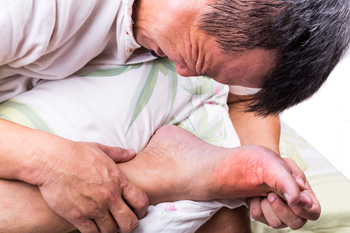 The pain and discomfort that often accompanies the medical condition that is known as gout can be described as severe and intense. It is considered to be a form of arthritis, and typically affects the joints surrounding the big toe. It is generally caused by elevated uric acid levels in the blood, and can develop from eating foods that have high purine levels. These types of food can consist of shellfish, red meat, and sugary drinks. Additionally, genetic factors may play a significant role in developing gout. Mild relief may be found when joint pain is controlled, and this may be accomplished by taking an anti-inflammatory medication. Painful gout attacks may be avoided when a healthy food plan is implemented. This can also include limiting alcoholic beverages and losing excess weight. If you suffer from gout, it is strongly suggested that you consult with a podiatrist who can help you to manage this condition.
The pain and discomfort that often accompanies the medical condition that is known as gout can be described as severe and intense. It is considered to be a form of arthritis, and typically affects the joints surrounding the big toe. It is generally caused by elevated uric acid levels in the blood, and can develop from eating foods that have high purine levels. These types of food can consist of shellfish, red meat, and sugary drinks. Additionally, genetic factors may play a significant role in developing gout. Mild relief may be found when joint pain is controlled, and this may be accomplished by taking an anti-inflammatory medication. Painful gout attacks may be avoided when a healthy food plan is implemented. This can also include limiting alcoholic beverages and losing excess weight. If you suffer from gout, it is strongly suggested that you consult with a podiatrist who can help you to manage this condition.
Gout is a foot condition that requires certain treatment and care. If you are seeking treatment, contact Dr. Kendall Blackwell from InStride Wilson Podiatry Associates. Our doctor will treat your foot and ankle needs.
What Is Gout?
Gout is a type of arthritis caused by a buildup of uric acid in the bloodstream. It often develops in the foot, especially the big toe area, although it can manifest in other parts of the body as well. Gout can make walking and standing very painful and is especially common in diabetics and the obese.
People typically get gout because of a poor diet. Genetic predisposition is also a factor. The children of parents who have had gout frequently have a chance of developing it themselves.
Gout can easily be identified by redness and inflammation of the big toe and the surrounding areas of the foot. Other symptoms include extreme fatigue, joint pain, and running high fevers. Sometimes corticosteroid drugs can be prescribed to treat gout, but the best way to combat this disease is to get more exercise and eat a better diet.
If you have any questions please feel free to contact our office located in Wilson, NC . We offer the newest diagnostic and treatment technologies for all your foot and ankle needs.
How Do Ankle Sprains Occur?
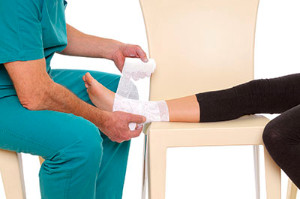 Ankle sprains are considered to be a common injury to the lower leg. They can happen when the ankle suddenly twists, or lands on the ground in an unnatural way. This can occur while participating in sporting activities, or from unexpectedly stepping off of a curb. The symptoms that are commonly associated with this type of injury include severe pain and discomfort, swelling, and it is generally difficult to walk. Relief can be found when the affected foot is elevated, and this may help to diminish a portion of the swelling. A proper diagnosis typically consists of having an X-ray performed, and this is advantageous in eliminating the possibility of a fracture. An effective treatment technique can consist of wrapping the ankle in a bandage, which is often helpful in providing the support that is needed for healing. If you have sprained your ankle, it is advised that you consult with a podiatrist who can help you to properly heal.
Ankle sprains are considered to be a common injury to the lower leg. They can happen when the ankle suddenly twists, or lands on the ground in an unnatural way. This can occur while participating in sporting activities, or from unexpectedly stepping off of a curb. The symptoms that are commonly associated with this type of injury include severe pain and discomfort, swelling, and it is generally difficult to walk. Relief can be found when the affected foot is elevated, and this may help to diminish a portion of the swelling. A proper diagnosis typically consists of having an X-ray performed, and this is advantageous in eliminating the possibility of a fracture. An effective treatment technique can consist of wrapping the ankle in a bandage, which is often helpful in providing the support that is needed for healing. If you have sprained your ankle, it is advised that you consult with a podiatrist who can help you to properly heal.
Ankle sprains are common but need immediate attention. If you need your feet checked, contact Dr. Kendall Blackwell from InStride Wilson Podiatry Associates. Our doctor can provide the care you need to keep you pain-free and on your feet.
How Does an Ankle Sprain Occur?
Ankle sprains take place when the ligaments in your ankle are torn or stretched beyond their limits. There are multiple ways that the ankle can become injured, including twisting or rolling over onto your ankle, putting undue stress on it, or causing trauma to the ankle itself.
What Are the Symptoms?
- Mild to moderate bruising
- Limited mobility
- Swelling
- Discoloration of the skin (depending on severity)
Preventing a Sprain
- Wearing appropriate shoes for the occasion
- Stretching before exercises and sports
- Knowing your limits
Treatment of a Sprain
Treatment of a sprain depends on the severity. Many times, people are told to rest and remain off their feet completely, while others are given an air cast. If the sprain is very severe, surgery may be required.
If you have suffered an ankle sprain previously, you may want to consider additional support such as a brace and regular exercises to strengthen the ankle.
If you have any questions please feel free to contact our office located in Wilson, NC . We offer the newest diagnostic and treatment technologies for all your foot and ankle needs.
Methods That May Diminish the Chances of Falling
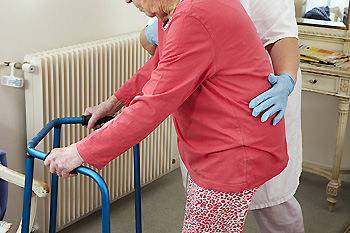 Research has indicated that individuals who are sixty-five years or older commonly fall, which can result in physical injuries. If falling has occurred, elderly people may become fearful of performing daily activities. This can lead to becoming inactive, and depression may occur. There are methods that can be implemented which may help to diminish the risk of falling. These can include having regular vision tests performed, and modifying the home environment by installing grab bars in the bathroom area. Additionally, it is beneficial to remove existing rugs that are loose, and it is helpful to have medications reviewed. If you would like additional information about how falling can affect the feet, it is suggested that you speak with a podiatrist.
Research has indicated that individuals who are sixty-five years or older commonly fall, which can result in physical injuries. If falling has occurred, elderly people may become fearful of performing daily activities. This can lead to becoming inactive, and depression may occur. There are methods that can be implemented which may help to diminish the risk of falling. These can include having regular vision tests performed, and modifying the home environment by installing grab bars in the bathroom area. Additionally, it is beneficial to remove existing rugs that are loose, and it is helpful to have medications reviewed. If you would like additional information about how falling can affect the feet, it is suggested that you speak with a podiatrist.
Preventing falls among the elderly is very important. If you are older and have fallen or fear that you are prone to falling, consult with Dr. Kendall Blackwell from InStride Wilson Podiatry Associates. Our doctor will assess your condition and provide you with quality advice and care.
Every 11 seconds, an elderly American is being treated in an emergency room for a fall related injury. Falls are the leading cause of head and hip injuries for those 65 and older. Due to decreases in strength, balance, senses, and lack of awareness, elderly persons are very susceptible to falling. Thankfully, there are a number of things older persons can do to prevent falls.
How to Prevent Falls
Some effective methods that older persons can do to prevent falls include:
- Enrolling in strength and balance exercise program to increase balance and strength
- Periodically having your sight and hearing checked
- Discuss any medications you have with a doctor to see if it increases the risk of falling
- Clearing the house of falling hazards and installing devices like grab bars and railings
- Utilizing a walker or cane
- Wearing shoes that provide good support and cushioning
- Talking to family members about falling and increasing awareness
Falling can be a traumatic and embarrassing experience for elderly persons; this can make them less willing to leave the house, and less willing to talk to someone about their fears of falling. Doing such things, however, will increase the likelihood of tripping or losing one’s balance. Knowing the causes of falling and how to prevent them is the best way to mitigate the risk of serious injury.
If you have any questions, please feel free to contact our office located in Wilson, NC . We offer the newest diagnostic and treatment technologies for all your foot care needs.
Achilles Tendon and Overuse
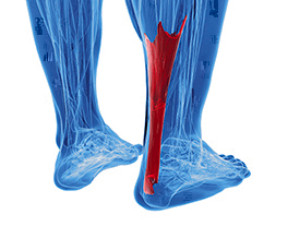 The Achilles tendon is known to be the largest tendon in the body. It connects the calf muscles to the heel, and it enables us to walk and perform running and jumping activities. Tendonitis may develop as a result of gradual damage that can stem from overuse. Patients who experience this type of injury typically have pain and discomfort in their calf and heel area. Additionally, it may be difficult to flex the foot, and there can be tenderness upon arising in the morning. Many patients may find relief by performing certain stretches that can strengthen the calf muscles. It may also be beneficial to wear orthotics as they can help heal an Achilles tendon injury. After a proper diagnosis is performed, which typically consists of having and MRI or X-ray taken, the correct treatment methods can begin. If you have endured this type of injury, it is suggested that you consult with a podiatrist who can offer you the best treatment options.
The Achilles tendon is known to be the largest tendon in the body. It connects the calf muscles to the heel, and it enables us to walk and perform running and jumping activities. Tendonitis may develop as a result of gradual damage that can stem from overuse. Patients who experience this type of injury typically have pain and discomfort in their calf and heel area. Additionally, it may be difficult to flex the foot, and there can be tenderness upon arising in the morning. Many patients may find relief by performing certain stretches that can strengthen the calf muscles. It may also be beneficial to wear orthotics as they can help heal an Achilles tendon injury. After a proper diagnosis is performed, which typically consists of having and MRI or X-ray taken, the correct treatment methods can begin. If you have endured this type of injury, it is suggested that you consult with a podiatrist who can offer you the best treatment options.
Achilles tendon injuries need immediate attention to avoid future complications. If you have any concerns, contact Dr. Kendall Blackwell of InStride Wilson Podiatry Associates. Our doctor can provide the care you need to keep you pain-free and on your feet.
What Is the Achilles Tendon?
The Achilles tendon is a tendon that connects the lower leg muscles and calf to the heel of the foot. It is the strongest tendon in the human body and is essential for making movement possible. Because this tendon is such an integral part of the body, any injuries to it can create immense difficulties and should immediately be presented to a doctor.
What Are the Symptoms of an Achilles Tendon Injury?
There are various types of injuries that can affect the Achilles tendon. The two most common injuries are Achilles tendinitis and ruptures of the tendon.
Achilles Tendinitis Symptoms
- Inflammation
- Dull to severe pain
- Increased blood flow to the tendon
- Thickening of the tendon
Rupture Symptoms
- Extreme pain and swelling in the foot
- Total immobility
Treatment and Prevention
Achilles tendon injuries are diagnosed by a thorough physical evaluation, which can include an MRI. Treatment involves rest, physical therapy, and in some cases, surgery. However, various preventative measures can be taken to avoid these injuries, such as:
- Thorough stretching of the tendon before and after exercise
- Strengthening exercises like calf raises, squats, leg curls, leg extensions, leg raises, lunges, and leg presses
If you have any questions please feel free to contact our office located in Wilson, NC . We offer the newest diagnostic tools and technology to treat your foot and ankle needs.
Arthritis Can Cause Pain in the Feet and Ankles
Flat Feet Symptoms and Causes
You have flat feet when the en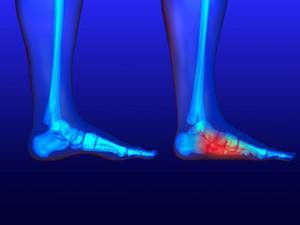 tire soles of your feet can touch the floor when you stand up. It is a very common and usually painless condition that occurs when the arches do not develop during childhood. It can also happen after an injury or from the stress brought upon by age. The majority of people that have flat feet will not show any signs or symptoms. Occasionally foot pain can surface in the heel or arch area. Flat feet is most common in infants and toddlers as the arches of their feet have yet to develop at this age. Most arches will develop throughout childhood, but there are some that will never develop them. Factors that can increase your risk of flat feet include obesity, diabetes, rheumatoid arthritis, injury to the foot or ankle and aging. If you are experiencing pain as a result of flat feet, it is advised that you consult with a podiatrist.
tire soles of your feet can touch the floor when you stand up. It is a very common and usually painless condition that occurs when the arches do not develop during childhood. It can also happen after an injury or from the stress brought upon by age. The majority of people that have flat feet will not show any signs or symptoms. Occasionally foot pain can surface in the heel or arch area. Flat feet is most common in infants and toddlers as the arches of their feet have yet to develop at this age. Most arches will develop throughout childhood, but there are some that will never develop them. Factors that can increase your risk of flat feet include obesity, diabetes, rheumatoid arthritis, injury to the foot or ankle and aging. If you are experiencing pain as a result of flat feet, it is advised that you consult with a podiatrist.
Flatfoot is a condition many people suffer from. If you have flat feet, contact Dr. Kendall Blackwell from InStride Wilson Podiatry Associates. Our doctor will treat your foot and ankle needs.
What Are Flat Feet?
Flatfoot is a condition in which the arch of the foot is depressed and the sole of the foot is almost completely in contact with the ground. About 20-30% of the population generally has flat feet because their arches never formed during growth.
Conditions & Problems:
Having flat feet makes it difficult to run or walk because of the stress placed on the ankles.
Alignment – The general alignment of your legs can be disrupted, because the ankles move inward which can cause major discomfort.
Knees – If you have complications with your knees, flat feet can be a contributor to arthritis in that area.
Symptoms
- Pain around the heel or arch area
- Trouble standing on the tip toe
- Swelling around the inside of the ankle
- Flat look to one or both feet
- Having your shoes feel uneven when worn
Treatment
If you are experiencing pain and stress on the foot you may weaken the posterior tibial tendon, which runs around the inside of the ankle.
If you have any questions please feel free to contact our office located in Wilson, NC . We offer the newest diagnostic and treatment technologies for all your foot and ankle needs.
Toddlers And Walking Barefoot
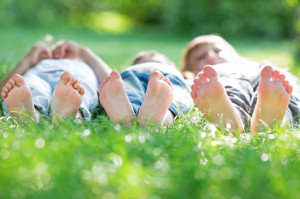 There are several bones, joints, and ligaments that the human foot is comprised of. When babies are born, their feet are flexible, and will gradually become stronger as walking begins. Babies are typically born with flat feet, and the arch generally develops as the feet become stronger. Research has indicated that it is beneficial for toddlers to walk barefoot while indoors, and this can help the toes to strengthen by grasping the floor. When the first pair of shoes are purchased, the feet should be properly measured, and this is helpful in determining the correct shoe size. It is important that the shoes have flat and flexible soles, in addition to ensuring that there is inadequate room for the toes to move freely in. If you would like more information about how to care for your child’s feet, please consult with a podiatrist.
There are several bones, joints, and ligaments that the human foot is comprised of. When babies are born, their feet are flexible, and will gradually become stronger as walking begins. Babies are typically born with flat feet, and the arch generally develops as the feet become stronger. Research has indicated that it is beneficial for toddlers to walk barefoot while indoors, and this can help the toes to strengthen by grasping the floor. When the first pair of shoes are purchased, the feet should be properly measured, and this is helpful in determining the correct shoe size. It is important that the shoes have flat and flexible soles, in addition to ensuring that there is inadequate room for the toes to move freely in. If you would like more information about how to care for your child’s feet, please consult with a podiatrist.
Making sure that your children maintain good foot health is very important as they grow. If you have any questions, contact Dr. Kendall Blackwell of InStride Wilson Podiatry Associates. Our doctor can provide the care you need to keep you pain-free and on your feet.
Keeping Children's Feet Healthy
Having healthy feet during childhood can help prevent medical problems later in life, namely in the back and legs. As children grow, their feet require different types of care. Here are some things to consider...
Although babies do not walk yet, it is still very important to take care of their feet.
Avoid putting tight shoes or socks on his or her feet.
Allow the baby to stretch and kick his or her feet to feel comfortable.
As a toddler, kids are now on the move and begin to develop differently. At this age, toddlers are getting a feel for walking, so don’t be alarmed if your toddler is unsteady or ‘walks funny’.
As your child gets older, it is important to teach them how to take care of their feet.
Show them proper hygiene to prevent infections such as fungus.
Be watchful for any pain or injury.
Have all injuries checked by a doctor as soon as possible.
Comfortable, protective shoes should always be worn, especially at play.
If you have any questions please feel free to contact our office located in Wilson, NC . We offer the newest diagnostic and treatment technologies for all your foot and ankle needs.
How to Protect Your Feet During the Work Day
 There are many people who spend the majority of their working day standing or walking. Research has indicated it is beneficial to wear shoes that fit properly, and this may help to prevent painful foot conditions from developing. It is helpful to make sure there is enough room for the toes to move freely in, and the feet will feel better when there is adequate cushioning and support. Resting the feet as frequently as possible may aid in reducing foot pain that comes from standing for extended periods of time. Additionally, it is important to choose shoes and socks that are made of breathable materials, as this can help to provide maximum comfort. Please consult with a podiatrist if you would like additional information about how to protect your feet while working.
There are many people who spend the majority of their working day standing or walking. Research has indicated it is beneficial to wear shoes that fit properly, and this may help to prevent painful foot conditions from developing. It is helpful to make sure there is enough room for the toes to move freely in, and the feet will feel better when there is adequate cushioning and support. Resting the feet as frequently as possible may aid in reducing foot pain that comes from standing for extended periods of time. Additionally, it is important to choose shoes and socks that are made of breathable materials, as this can help to provide maximum comfort. Please consult with a podiatrist if you would like additional information about how to protect your feet while working.
While working on the feet, it is important to take the proper care of them. For more information about working on your feet, contact Dr. Kendall Blackwell from InStride Wilson Podiatry Associates. Our doctor will treat your foot and ankle needs.
Working on Your Feet
Standing on your feet for long periods of time can cause stress and pain in your feet. Your whole body may experience change in terms of posture, back pain, bunions, callouses and or plantar warts. There are ways to avoid these conditions with proper foot care, smart choices and correct posture.
Positive Changes
Negative heeled shoe – Choosing this shoe type places the heel slightly lower than the ball of the foot. These are great for overall foot health. Find shoes that fit you correctly.
Go barefoot – Our feet were not designed to be enclosed for all hours of the day. Try to periodically expose your feet to air.
Eliminate Pain
Foot Exercises – Performing simple exercises, incorporating yoga and doing stretches are beneficial. This will allow increased blood flow to the area and muscles of the foot.
Achilles tendon – Stretching the foot out flat on the floor will relax the calf muscles and tendon. These exercises can be performed almost anywhere. Make sure you add these exercises to your daily regimen.
With a little bit of this information and knowing more about foot health, you will notice changes. Foot stretches and proper footwear will help with pain and prevent further issues.
If you have any questions please feel free to contact our office located in Wilson, NC . We offer the newest diagnostic and treatment technologies for all your foot and ankle needs.
More...
Methods on Maintaining Proper Foot Care
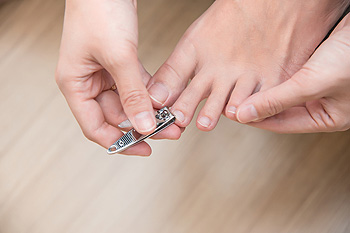 When the feet are properly cared for on a daily basis, certain foot conditions may be prevented from occurring. Athlete’s foot may be avoided when the feet are washed and thoroughly dried daily, especially between the toes. When a good moisturizer is applied, it may help to prevent cracked heels from developing. The importance of trimming the toenails properly is necessary in possibly preventing the painful condition known as ingrown toenails. Additionally, the feet will feel more comfortable when the correct size shoe is worn, and this can be accomplished if shoes are tried on in the afternoon when the feet are their largest. If you would like additional information about how to maintain proper foot care, it is advised to seek the counsel of a podiatrist.
When the feet are properly cared for on a daily basis, certain foot conditions may be prevented from occurring. Athlete’s foot may be avoided when the feet are washed and thoroughly dried daily, especially between the toes. When a good moisturizer is applied, it may help to prevent cracked heels from developing. The importance of trimming the toenails properly is necessary in possibly preventing the painful condition known as ingrown toenails. Additionally, the feet will feel more comfortable when the correct size shoe is worn, and this can be accomplished if shoes are tried on in the afternoon when the feet are their largest. If you would like additional information about how to maintain proper foot care, it is advised to seek the counsel of a podiatrist.
Everyday foot care is very important to prevent infection and other foot ailments. If you need your feet checked, contact Dr. Kendall Blackwell from InStride Wilson Podiatry Associates. Our doctor can provide the care you need to keep you pain-free and on your feet.
Everyday Foot Care
Often, people take care of their bodies, face and hair more so than they do for their feet. But the feet are a very important aspect of our bodies, and one that we should pay more attention to. Without our feet, we would not be able to perform most daily tasks.
It is best to check your feet regularly to make sure there are no new bruises or cuts that you may not have noticed before. For dry feet, moisturizer can easily be a remedy and can be applied as often as necessary to the affected areas. Wearing shoes that fit well can also help you maintain good foot health, as well as making it easier to walk and do daily activities without the stress or pain of ill-fitting shoes, high heels, or even flip flops. Wearing clean socks with closed shoes is important to ensure that sweat and bacteria do not accumulate within the shoe. Clean socks help to prevent Athlete’s foot, fungi problems, bad odors, and can absorb sweat.
If you have any questions please feel free to contact our office located in Wilson, NC . We offer the newest diagnostic and treatment technologies for all your foot and ankle needs.
What are Achilles Tendon Injuries?
The  Achilles tendon is a fibrous band of tissue that links the muscles from your calf to your heel. The flexibility of the tendon is key for jumping, running, and walking. The Achilles bears a lot of stress and pressure during everyday activities, as well as during athletic and recreational play. If it becomes inflamed, swollen or irritated, it is called tendonitis. The most common risk factors for Achilles tendon injuries are starting a new sport, an increased amount or intensity of an activity, bone spurs on the heels, tight calf muscles when starting an activity, and wearing improper shoes when exercising. Common symptoms of Achilles tendon injuries include the following: pain that gets worse while being active, a stiff/sore Achilles tendon when first getting up in the morning, thickening of the tendon, and difficulty in flexing the affected foot. Some treatment options are rest, physical therapy, specific exercises to strengthen the calf muscles, and anti-inflammatory drugs for pain relief such as ibuprofen or naproxen. An Achilles tendon injury may be prevented by stretching before exercising and by wearing the correct shoes. It may be suggested to cease exercise on uneven surfaces and stop activities that cause pain. If you have an Achilles injury or if you would like to take precautions to prevent an Achilles injury, please consult with your local podiatrist.
Achilles tendon is a fibrous band of tissue that links the muscles from your calf to your heel. The flexibility of the tendon is key for jumping, running, and walking. The Achilles bears a lot of stress and pressure during everyday activities, as well as during athletic and recreational play. If it becomes inflamed, swollen or irritated, it is called tendonitis. The most common risk factors for Achilles tendon injuries are starting a new sport, an increased amount or intensity of an activity, bone spurs on the heels, tight calf muscles when starting an activity, and wearing improper shoes when exercising. Common symptoms of Achilles tendon injuries include the following: pain that gets worse while being active, a stiff/sore Achilles tendon when first getting up in the morning, thickening of the tendon, and difficulty in flexing the affected foot. Some treatment options are rest, physical therapy, specific exercises to strengthen the calf muscles, and anti-inflammatory drugs for pain relief such as ibuprofen or naproxen. An Achilles tendon injury may be prevented by stretching before exercising and by wearing the correct shoes. It may be suggested to cease exercise on uneven surfaces and stop activities that cause pain. If you have an Achilles injury or if you would like to take precautions to prevent an Achilles injury, please consult with your local podiatrist.
Achilles tendon injuries need immediate attention to avoid future complications. If you have any concerns, contact Dr. Kendall Blackwell of InStride Wilson Podiatry Associates. Our doctor can provide the care you need to keep you pain-free and on your feet.
What Is the Achilles Tendon?
The Achilles tendon is a tendon that connects the lower leg muscles and calf to the heel of the foot. It is the strongest tendon in the human body and is essential for making movement possible. Because this tendon is such an integral part of the body, any injuries to it can create immense difficulties and should immediately be presented to a doctor.
What Are the Symptoms of an Achilles Tendon Injury?
There are various types of injuries that can affect the Achilles tendon. The two most common injuries are Achilles tendinitis and ruptures of the tendon.
Achilles Tendinitis Symptoms
- Inflammation
- Dull to severe pain
- Increased blood flow to the tendon
- Thickening of the tendon
Rupture Symptoms
- Extreme pain and swelling in the foot
- Total immobility
Treatment and Prevention
Achilles tendon injuries are diagnosed by a thorough physical evaluation, which can include an MRI. Treatment involves rest, physical therapy, and in some cases, surgery. However, various preventative measures can be taken to avoid these injuries, such as:
- Thorough stretching of the tendon before and after exercise
- Strengthening exercises like calf raises, squats, leg curls, leg extensions, leg raises, lunges, and leg presses
If you have any questions please feel free to contact our office located in Wilson, NC . We offer the newest diagnostic tools and technology to treat your foot and ankle needs.
Gout Pain Can Be Managed
Different Types of Toe Fractures
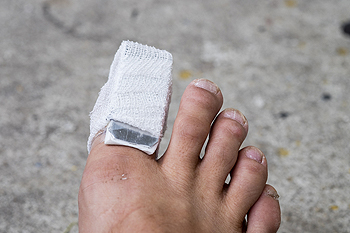 The toes play a significant role in maintaining balance in the body while standing, in addition to pursuing walking and running activities. The bones are small, and can easily break if something heavy is dropped on one of them, or if it bangs against a piece of furniture. There are noticeable symptoms of a broken toe. These often consist of immediate pain, discomfort, redness, and the affected area may appear to be bruised and swollen. Research has shown there are several different types of breaks. A traumatic fracture consists of a sudden break, and this can occur from falling, or severely stubbing the toe. Additionally, if extended periods of time are spent in running activities, the toes may endure stress fractures. This can be a result of a gradual weakening of the bones in the toes. A fracture is considered to be severe if a bone is protruding from the skin, and an infection may occur from the open wound. If you have broken your toe, it is suggested to seek the counsel of a podiatrist who can properly diagnose and treat this condition.
The toes play a significant role in maintaining balance in the body while standing, in addition to pursuing walking and running activities. The bones are small, and can easily break if something heavy is dropped on one of them, or if it bangs against a piece of furniture. There are noticeable symptoms of a broken toe. These often consist of immediate pain, discomfort, redness, and the affected area may appear to be bruised and swollen. Research has shown there are several different types of breaks. A traumatic fracture consists of a sudden break, and this can occur from falling, or severely stubbing the toe. Additionally, if extended periods of time are spent in running activities, the toes may endure stress fractures. This can be a result of a gradual weakening of the bones in the toes. A fracture is considered to be severe if a bone is protruding from the skin, and an infection may occur from the open wound. If you have broken your toe, it is suggested to seek the counsel of a podiatrist who can properly diagnose and treat this condition.
A broken toe can be very painful and lead to complications if not properly fixed. If you have any concerns about your feet, contact Dr. Kendall Blackwell from InStride Wilson Podiatry Associates. Our doctor will treat your foot and ankle needs.
What to Know About a Broken Toe
Although most people try to avoid foot trauma such as banging, stubbing, or dropping heavy objects on their feet, the unfortunate fact is that it is a common occurrence. Given the fact that toes are positioned in front of the feet, they typically sustain the brunt of such trauma. When trauma occurs to a toe, the result can be a painful break (fracture).
Symptoms of a Broken Toe
- Throbbing pain
- Swelling
- Bruising on the skin and toenail
- The inability to move the toe
- Toe appears crooked or disfigured
- Tingling or numbness in the toe
Generally, it is best to stay off of the injured toe with the affected foot elevated.
Severe toe fractures may be treated with a splint, cast, and in some cases, minor surgery. Due to its position and the pressure it endures with daily activity, future complications can occur if the big toe is not properly treated.
If you have any questions please feel free to contact our office located in Wilson, NC . We offer the newest diagnostic and treatment technologies for all your foot and ankle needs.



